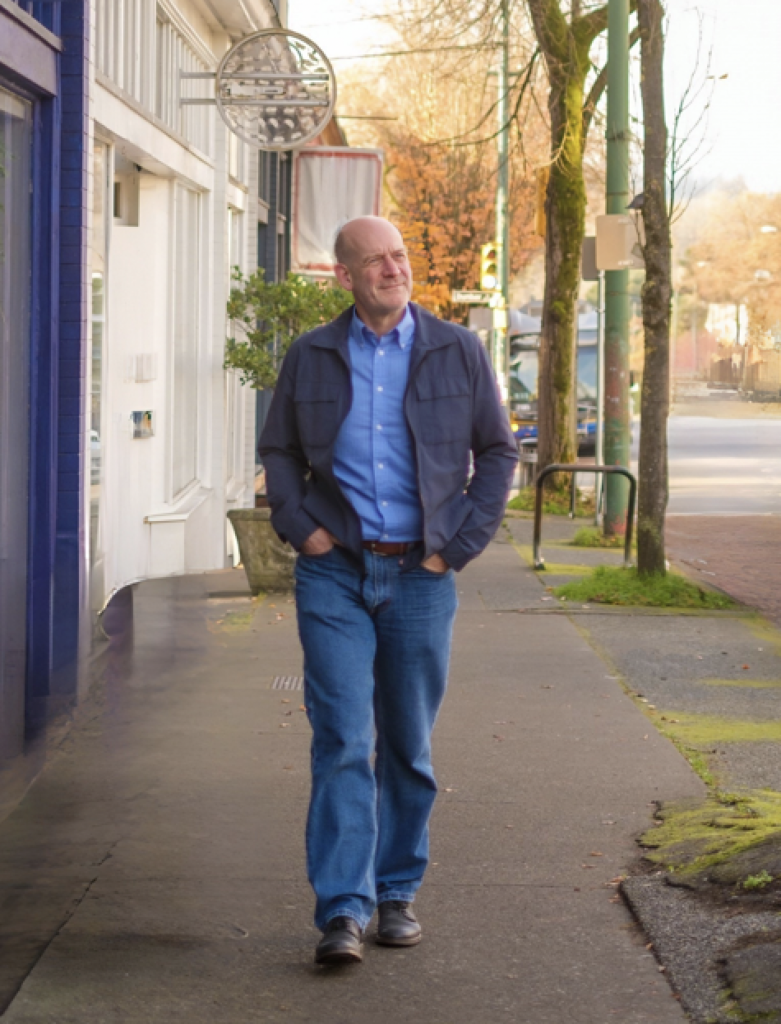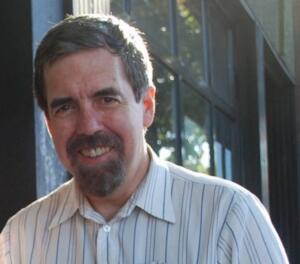Whose stories make up Vancouver?
A Perfect Day for a Walk: The History, Cultures, and Communities of Vancouver, on Foot
by Bill Arnott
Vancouver: Arsenal Pulp Press, 2024
$24.95 / 9781551529639
Reviewed by Sheldon Goldfarb
*

If I were writing this book – but that’s silly – I will never write such a book. I do walk sometimes (my doctors recommend it), but I hardly notice my surroundings – I’m lost in thought or trying to figure out how much further I have to go.
Bill Arnott is different: he’s looking around. And what does he see? Not what I would see. In the middle of reading this book, I thought, Let’s look around on a walk like he does. Or on the bus. And I walked along 8th east of Sasamat, and saw greenery and water and mountains. Quite beautiful. And later on the 4th Avenue bus I looked out the window and saw people, old and young, walking their dogs, or on their bicycles, or just walking.
Bill Arnott does see people occasionally, but mostly he sees bridges and buildings and architecture. Or art installations – who knew there were so many in Vancouver? Or plaques. And birds, trees, crows, seagulls, maples, and bamboo (there’s bamboo in Vancouver?). And sometimes he tells you interesting things, like Anna’s Hummingbird is the city bird. Really? When did that happen? (2017, actually.) And occasionally, very occasionally, he talks to people.
He meets an aging hippie in Kitsilano, complete with greying ponytail. They reminisce about the Summer of Love (1967), old music, the scene. Then the old hippie says things have gone bad lately. Why? Too much crime. He blames it on drugs. Drugs? The old hippie is complaining about drugs? Not the same sort of drugs, of course, but still, it’s hilarious. One wishes Bill would follow up, but he hurries on – avoiding controversy?

He does avoid controversy, one realizes. Oh, there are plaques he stops to read about ancient controversies like the Komagata Maru incident or anti-Asian riots, or the On to Ottawa Trek, and he talks vaguely about oppression and power. Vancouver’s plaques give a vaguely progressive depiction of our city, condemning the evil ways of our forefathers and celebrating Indigenous culture, queer culture, labour unions, and the fight against climate change. There’s even one poster of a labourer that makes him think of proletarian propaganda – is Vancouver a Soviet city? No, no, it’s not like proletarian propaganda, Bill says, just “a hint at the importance of labour.”
I realize these things are lost on me as I wander around town, mostly immersed in a book, like Bill’s book, as I sit on the bus. But if not a Soviet city, what is Vancouver? I ask a friend: Messy, she says, full of irritable people. She’s thinking of the traffic jams. Traffic and construction, is that what Vancouver is? What does Bill Arnott say it is? He does have a conclusion in which he talks about stories: is Vancouver a city of stories? But he skims over those: he goes to a story-telling evening and tells us few details. People talk about humour and sadness and reward, or loneliness amidst the grandeur. Yes, and …? One yearns for detail.
Even detail about Bill Arnott. Who is Bill Arnott? The little bio at the back says he’s the bestselling author of this book (how do they know?) and other books like the Gone Viking series of travelogues … but who is he? Is he a Vancouver native? Apparently not, because he talks of how on arrival here people helpfully told him the mountains are always north. But his grandfather lived here, and the family came to visit from … somewhere in rural B.C., it seems.
So, no story about the author, and only the hint of stories about others. Mostly a series of settings focusing on the art installations and plaques around the city. And mansard roofs and Vancouver Specials. If you like architecture, you may enjoy Bill’s details about buildings and the Sun Yat-Sen Garden. I wouldn’t have minded a retelling of the story of the controversy over the building of our central library: is it like the Roman Colosseum? Should it be? But Bill just enumerates the architectural features and mentions the architect.
There is one funny moment when he checks his app to see if it’s safe to go walking, and the app says, ‘If you don’t mind the risk of rain, it will be all right.’ Hmm, says Bill, if you don’t mind the risk of rain, it’s always all right. Raincouver, that’s what we are.
*

Sheldon Goldfarb is the author of The Hundred-Year Trek: A History of Student Life at UBC (Heritage House, 2017), reviewed by Herbert Rosengarten. He has been the archivist for the UBC student society (the AMS) for more than twenty years and has also written a murder mystery and two academic books on the Victorian author William Makepeace Thackeray. His murder mystery, Remember, Remember (Bristol: UKA Press), was nominated for an Arthur Ellis crime writing award in 2005. His latest book, Sherlockian Musings: Thoughts on the Sherlock Holmes Stories (London: MX Publishing, 2019), was reviewed in The British Columbia Review by Patrick McDonagh. Originally from Montreal, Sheldon has a history degree from McGill University, a master’s degree in English from the University of Manitoba, and two degrees from the University of British Columbia: a PhD in English and a master’s degree in archival studies. [Editor’s note: For The British Columbia Review, Sheldon Goldfarb has reviewed books by paulo da costa, Chris Honey, Andrew Platten, Marcello Di Cintio, R. F. Vincent, and Nick Marino, and he has contributed a comedic poem, “The Ramen,” based on Poe’s “The Raven.”]
*
The British Columbia Review
Interim Editors, 2023-25: Trevor Marc Hughes (non-fiction), Brett Josef Grubisic (fiction and poetry)
Publisher: Richard Mackie
Formerly The Ormsby Review, The British Columbia Review is an online book review and journal service for BC writers and readers. The Advisory Board now consists of Jean Barman, Wade Davis, Robin Fisher, Barry Gough, Hugh Johnston, Kathy Mezei, Patricia Roy, Maria Tippett, and Graeme Wynn. Provincial Government Patron (since September 2018): Creative BC. Honorary Patron: Yosef Wosk. Scholarly Patron: SFU Graduate Liberal Studies. The British Columbia Review was founded in 2016 by Richard Mackie and Alan Twigg.
“Only connect.” – E.M. Forster
2 comments on “Whose stories make up Vancouver?”
From one old-timer to another, your review of Bill Arnott’s walking book was near perfect. Maybe it was perfect. You gave the reader much to consider about the book, but also took us on an intimate tour of your personal sense of Vancouver.
I also enjoyed your candid snippets in BC Review’s year-end roundup of the best of 2024. I may race out to my local library to borrow a copy of an Agatha Christie murder mystery to keep me company this evening.
Thank you for some fine review writing. You set the bar higher.
There’s a fairly large “walking Vancouver” literature, much of it written by women who favour poetic modes over exposition. Judith Copithorne, Maxine Gadd, Daphne Marlatt, Renee Rodin, Lisa Robertson, Meredith Quartermain account for a few of those over sixty.